Cats are one of the most popular pets in the world, and their fuzzy little faces have lived beside us for thousands of years. However, even after all that time, we still have trouble understanding our feline friends. Most pet owners would agree that trying to understand a creature that can’t talk can get frustrating. Since they’re incapable of human speech, we must rely on our cat’s body language and mannerisms to even begin to understand them.
A cat’s natural, enigmatic ways lead to a lot of confusion, especially for those who are more used to dogs. Even people who feel comfortable around cats can be unsure when faced with a new cat — in some ways, every cat has its own way of communicating that differs from other cats. However, core body language remains similar from cat to cat, with small variations we can think of as accents or dialects.
Cats speak with their whole bodies, from whisker to tail. Each body part can communicate part of what the cat’s saying and understanding each part will help you better understand your fur baby. Some actions and postures carry different meanings under different circumstances, though. With cats, context is everything. Let’s break it down, one part at a time, and look at what a cat’s body language could tell you in different situations.
The Tail
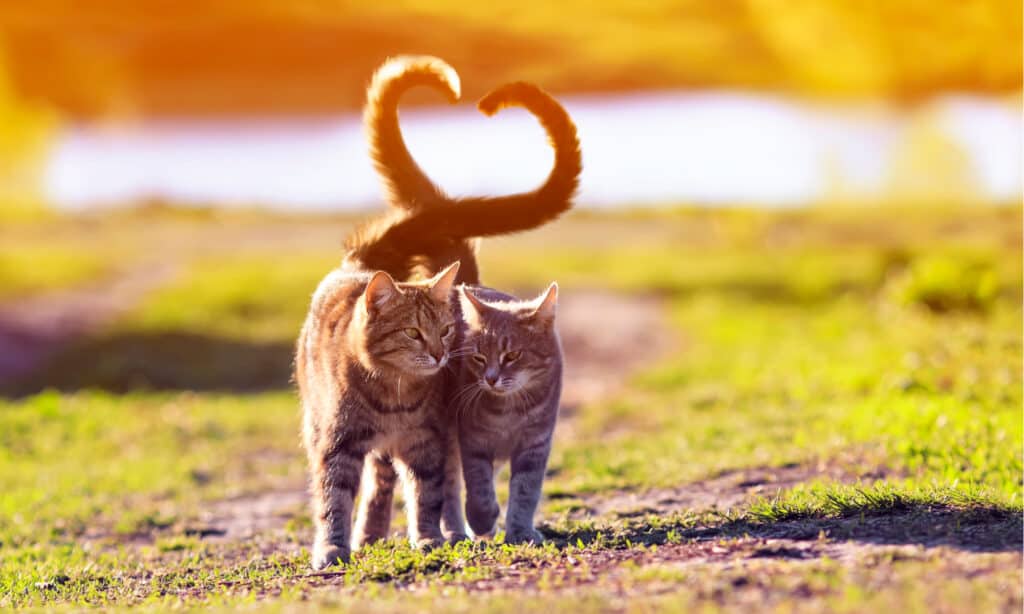
Cats use their tails for everything, including extra balance and communication through body language.
©Bachkova Natalia/Shutterstock.com
Starting in the rear, but for good reason! A cat’s tail is probably one of its most effective communication tools and one of the easiest to read for us. Cats’ tails are very flexible, meaning they can swish any which way to help get their meaning across. Here are some of the “tell-tail” positions you might see a cat use and what they mean in different contexts.
Up
A tail straight up can communicate multiple things. It can be happy and content or call for a fight. The difference lies in the context of the situation. Say you just got home or called your cat’s name. As they trot towards you, chances are their tail is up high, maybe with a little bend at the tip. Their tail might even quiver a little. This posture conveys their happiness to see you or their contentment with the general situation.
However, if a cat’s tail is straight up and they’re standing still, it can be a signal of alarm. Maybe something surprised them or something new entered their field of vision. If their tail is up and puffed out, they’re either very spooked or trying to make themselves look bigger to an aggressor. The aggressive posture usually includes an arched back and bristled fur along the back.
Down
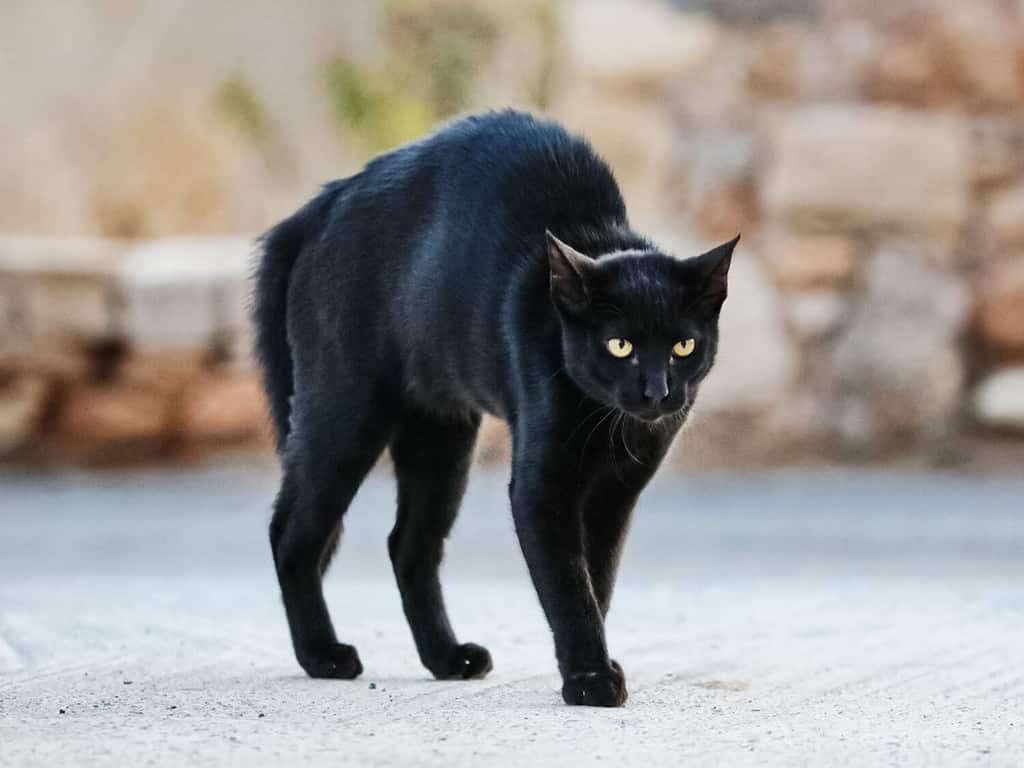
A pose with the tail down and bristled with the arched back conveys fear and aggression — this cat is prepared to fight.
©NZ3/Shutterstock.com
Like other animals, if a cat’s tail is down or tucked close to their body or between their legs, they’re scared. This isn’t the scared-so-let’s-fight type of fear, either. When they tuck their tails and curl up tight, a cat wants to appear as small as possible and hopefully be overlooked by whatever is happening. This happens frequently at the vet and in other similarly stressful situations or when faced with a much bigger, aggressive opponent.
If a cat’s tail is down and swishing back and forth at the end, that’s when the scared-aggression comes out. The cat won’t be curled into a ball, but standing as tall as possible, potentially also with an arched back. If you see this posture among your household cats, consider stepping in to diffuse the situation to keep the fur from flying.
However, when a cat hunts, its tail will behave similarly to the aggressive tail — low to the ground and flicking slightly. Context and the rest of the cat’s body language will inform you which is which. An aggressive cat stands up tall, while a hunting cat crouches low to the ground. An angry cat may make low, growling noises or loud yowls. A hunting cat is trying to be sneaky and will be silent, or make soft “ek-ek” sounds at the most.
The Body

One of the best indicators to gauge your cat’s mood is by observing its body’s signals.
©Lanova Daria/Shutterstock.com
Cats want to be understood and make their intentions plain with their body positions. Like many other creatures, cats tend to point their bodies in the direction they want to go in. This directionality helps while interpreting your cat’s meaning.
Facing You
Unlike other animals that see head-on postures as aggressive, cats use this posture to demonstrate their confidence and openness. They may even approach you to initiate contact. A cat facing you is one that’s ready for pets and snuggles.
Facing Sideways
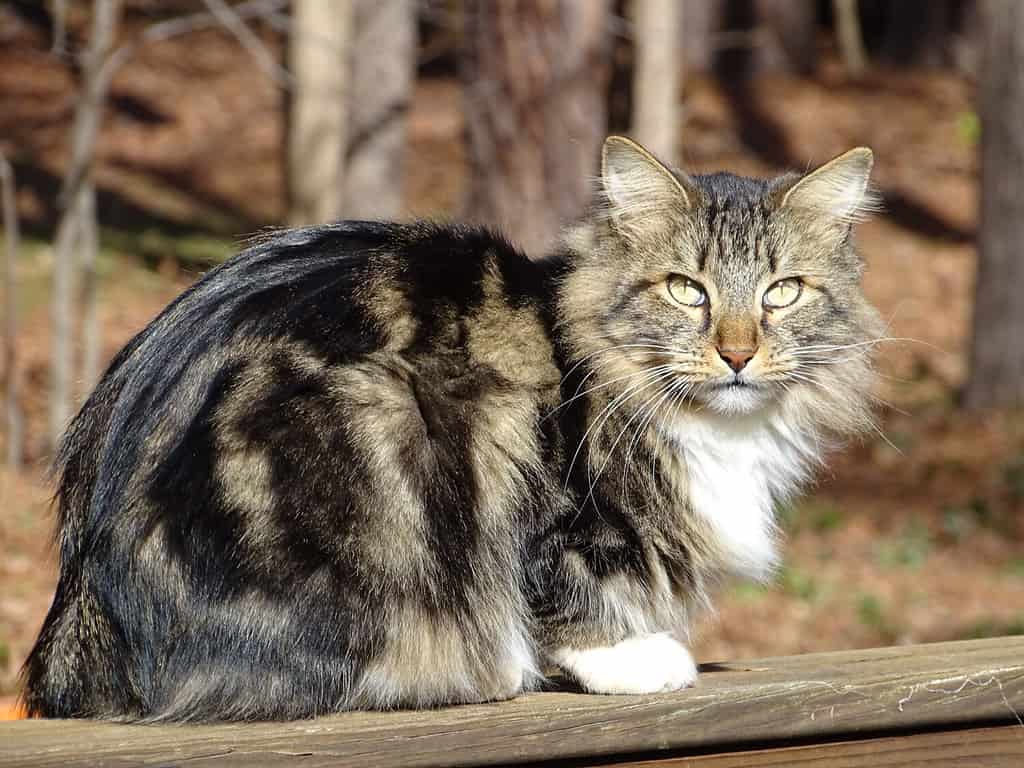
Cats tend to position their bodies in the direction they plan on moving. By facing sideways, a cat gives itself an easy exit if the need arises.
©Mary McDonald/Shutterstock.com
With their body pointed in a different direction, a cat can assess a situation and leave quickly if the need arises. Cats faced sideways are anxious, unsure, or cautious about what’s going on around them. If their back is arched, they also feel threatened. Some kind, soft words — in that irresistible baby voice we know cats love — can go a long way to helping an unsure cat feel more relaxed.
Facing Away
Consider this the highest kitty compliment! If your cat deliberately settles down with their back to you, they’re not being rude. In fact, they’re saying they trust you to watch their back. You make them feel safe enough that they can let down their guard. Now is not the time for sneak-attack cuddles, though. That trust can always be revoked.
Bellies Up

Cats protect their bellies from potential threats. If a cat shows you its belly, or leaves it exposed, they trust you not to hurt them.
©Fantastyczna Pasja/Shutterstock.com
Whether your cat lies down for a nap, stretches, or playfully rolls around, they trust you if they show you their belly. The belly is where cats are most vulnerable, so to display it takes a lot of trust. Beware the “cat trap” though! This is not an invitation to rub their belly, no matter how soft and fluffy it looks. Unless you know the cat and know it likes belly rubs, proceed with extreme caution. An unwanted belly rub will likely be met with teeth and claws.
Back Arches
Usually, when a cat arches their back, they want to appear big and scary. This comes in conjunction with facing sideways so it can appear as big as possible. If the cat is scared or threatened, the fur on their back will stand on end — another tactic to look bigger. The best response here is to back off, especially if you’re being treated as the scary thing. Otherwise, try to remove the threat or calm your kitty down.
However, cats also frequently arch their backs as a stretch mid- or post-nap. Sleeping for up to 16 hours a day can put a creak in your back without proper stretching! Again, context is key here — an angry or scared back arch will be easily distinguished from a sleepy back stretch.
The Ears

Cats have amazing hearing and use their ears both for hunting and communicating.
©Clare Louise Jackson/Shutterstock.com
Did you know that cats have 32 muscles in each ear? A cat’s ears can operate independently and turn 180 degrees to precisely pinpoint prey or a threat. Due to this incredible amount of movement, cats use their ears frequently to communicate.
Neutral
When calm and relaxed, a cat’s ears stand straight and point both forward and slightly out. They’re still listening to everything around them, and an ear might swivel occasionally, but the cat is relaxed and comfortable in their surroundings.
Tall and Erect
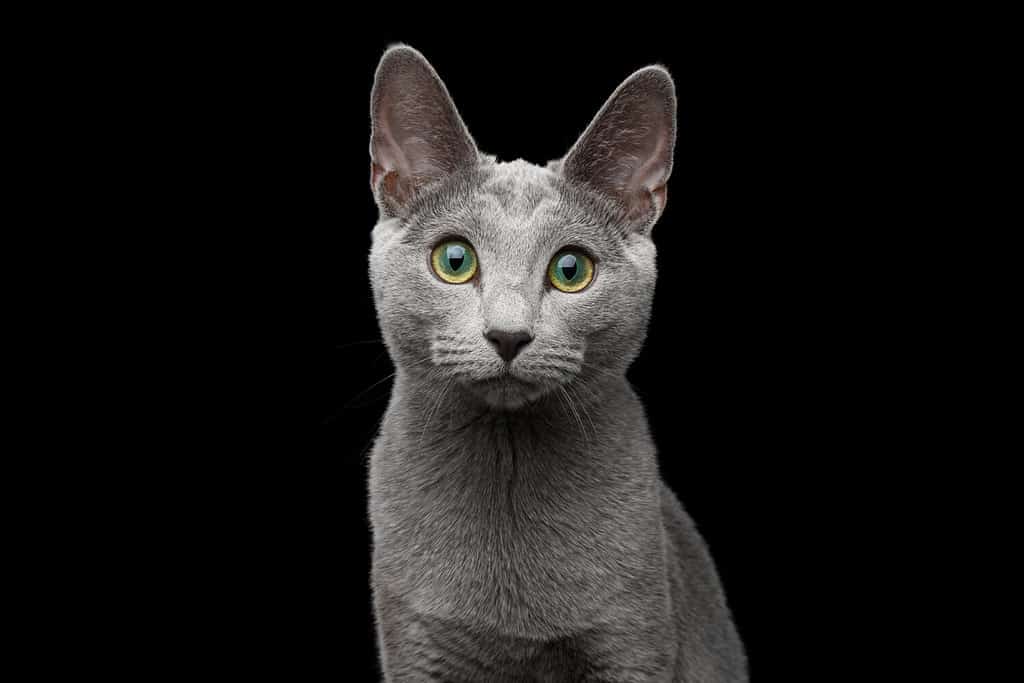
A cat who’s heard something interesting will use its powerful ears to pinpoint the sound.
©Seregraff/Shutterstock.com
The difference between neutral ears and active ears can be hard to describe but easy to spot. A cat that’s actively listening for something will have its ears perked up and pointing straight forward. They will move both their head and ears in an effort to track the sound that caught their attention.
Swiveling
Swiveling ears can be a sign of alertness and tracking, but it can also be a sign of unease or anxiety. In this case, a cat’s alertness isn’t due to an odd sound but is instead a response to an uncomfortable or unfamiliar situation. A cat swiveling its ears can be a signal that they’re making up their mind about the safety of their surroundings.
Flat Back
When scared or angry, a cat will flatten their ears back against their head. Usually, this posture accompanies a hiss or paw slap. This could be a reflex to protect their valuable appendages, or just to enhance the ferocity of the hiss. It’s best to back off if your cat flattens their ears.
The Eyes

Cats use their powerful eyes to survey their surroundings and to express themselves.
©Veronika Viskova/iStock via Getty Images
Like people, cats make a variety of facial expressions to convey their moods and thoughts. A cat’s eyes are incredibly sensitive to light and movement, making them excellent predators. Their eyes aren’t very communicative but can help inform other postures with more context.
Neutral Eyes
A happy, relaxed, and content cat’s eyes feature a rounded pupil that still picks up on everything around them but isn’t actively focused on anything. They blink regularly rather than staring and may even grace you with a slow, soft blink while looking at you. A slow blink is basically a kitty kiss, meaning they love and trust you.
Wide Pupils
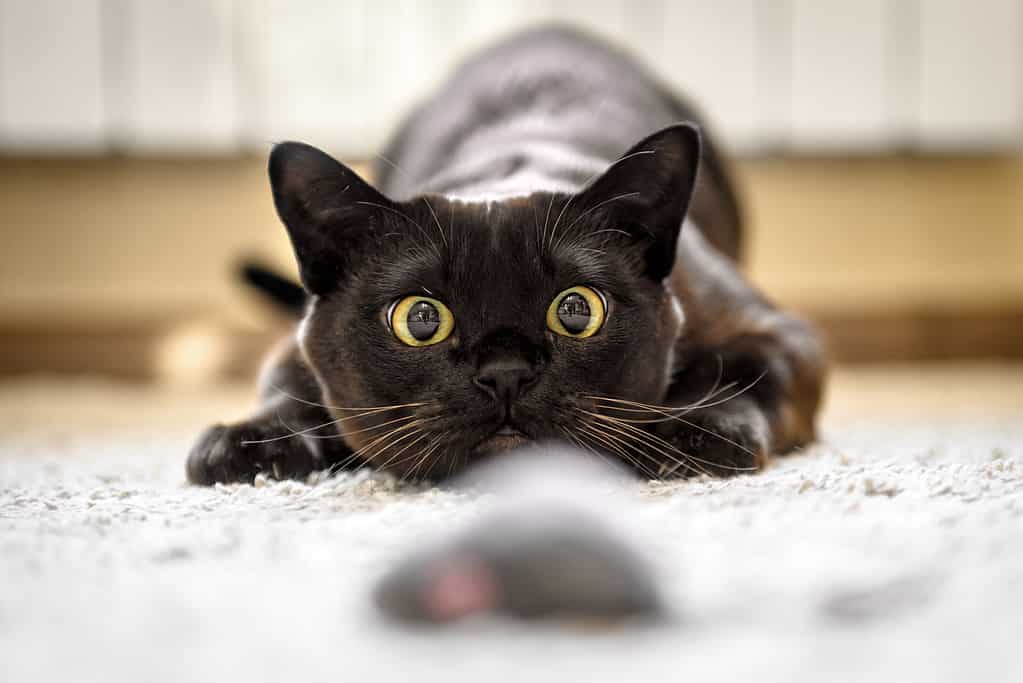
Cats’ eyes go wide when they’re excited or playful, or when they’re afraid.
©scaliger/iStock via Getty Images
When hunting, a cat’s pupils open wide to detect as much visual information as possible. A cat’s pupils go wide when they’re hunting, playing, or otherwise stalking. This can be a good indicator for that switch that seems to flip in cats — one minute, they’re sitting calmly, then suddenly their eyes go wide, and they pounce or go running. However, wide pupils can also indicate aggression or fear. The rest of the cat’s body language has to inform the correct assessment.
Tiny Pupils
A cat’s vertical pupils make for a unique eye shape, especially when their pupil shrinks down to a sliver. Though this, too, can signal aggressive intents, it could just as easily mean it’s really bright out. Cats naturally hunt in dim or dark lighting, so their eyes are more tuned for that lack of light. In the bright of day, sometimes it’s just too much for your kitty’s eyes.
Intent Staring
Cats are infamous for their stares, especially when there’s seemingly nothing there. Many cat owners joke that they can see ghosts or other visions we’re blind to, chalking up a cat’s unnerving gaze as paranormal protection. However, recent studies suggest that cats potentially see things we can’t — but instead of ghosts, they might see ultraviolet light and patterns.
Third Eyelid
Most mammals — except us primates — possess a third eyelid that helps keep the eye clean of debris and dust. Called a nictitating membrane in cats, this eyelid retracts into the inner corner of a cat’s eye, closest to their nose. Sometimes, if a cat sleeps deeply or just wakes up, the membrane is visible and hasn’t fully retracted yet. However, seeing a cat’s third eyelid more frequently could be a sign of an eye infection or other illness.
The Whiskers

An iconic part of a cat’s face, whiskers help cats make sense of the world around them.
©fantom_rd/Shutterstock.com
A cat’s whiskers are a vital part of their sensory system, right alongside their eyes, ears, and nose. They almost function similarly to an insect’s antennae, helping the cat map out their surroundings. Though they look like long hairs, whiskers are actually embedded directly into a cat’s muscular and nervous system, much deeper than their typical fur. As for their part in feline body language, whiskers have three positions that can add information to a cat’s overall posture.
Forward
Much like the way a cat’s pupils dilate for extra information while hunting or playing, whiskers do the same. When interested or engaged, a cat will push its whiskers forward to help with up-close vision and sensing its surroundings. This action often precedes the quintessential butt wiggle that comes in preparation for a pounce.
Neutral
A cat’s whiskers constantly provide sensory information to the brain, even down to the texture of an object in front of them. When a cat is relaxed, the whiskers are too. They lie flush to the face and point out.
Pulled In
In some situations, a cat can “suck in” their whiskers, similar to how humans can suck in our cheeks. This brings the whiskers closer to the body, pointing back instead of out. Generally, a cat will only do this when very afraid or stressed. The pulled-in whiskers will usually be accompanied by a tight crouch, tucked tail, and potentially flattened ears as well.
Other Cat Behaviors and Signals
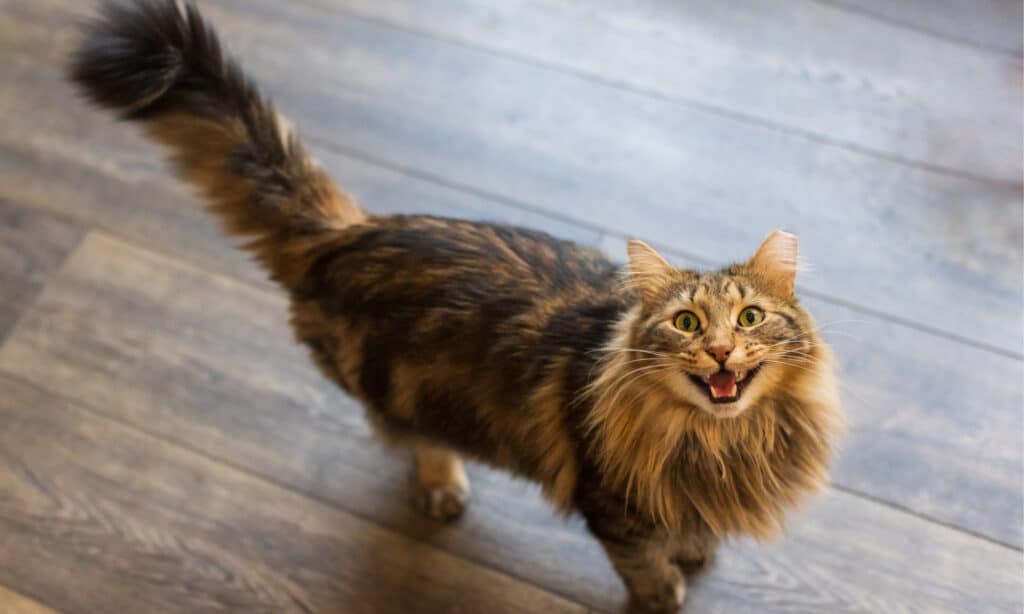
Cats adapted their sounds so humans can hear them, helping them communicate distress, boredom, or happiness.
©iStock.com/Svetlana Popova
In addition to all their other ways of communicating, cats use a variety of actions to help get their point across. Here are a couple of common behaviors cats display and what they might mean.
Vocalizations
Adult cats don’t use meows to communicate with each other— that behavior is reserved for kittens and humans, whose ears can’t pick up the other noises cats make. Current studies estimate that cats use up to 21 different sounds, though it’s widely accepted that there are probably many more — cats can be uncooperative test subjects in academic settings. From purrs and trills to hisses, growls, and yowls, cats have found many ways to communicate with our deaf human ears. Some cats like to chat more than others, too. For example, Russian Blue cats remain rather stoic while Siamese converse far more freely.
Rubbing
One of the primary ways cats communicate is through smell. Cats rub their cheeks, heads, and bodies on things to mark them as their territory. So when a cat rubs on your leg or face, they’re claiming you as their own.
Kneading
Often referred to as “making biscuits,” kneading behavior displays feelings of relaxation and safety. The action is a carry-over from their kittenhood when your cat got milk from their mother. Kneading stimulates milk production in mother cats, so even though their claws can hurt when they flex their paws when your cat kneads you, it’s a huge compliment!
Scratching
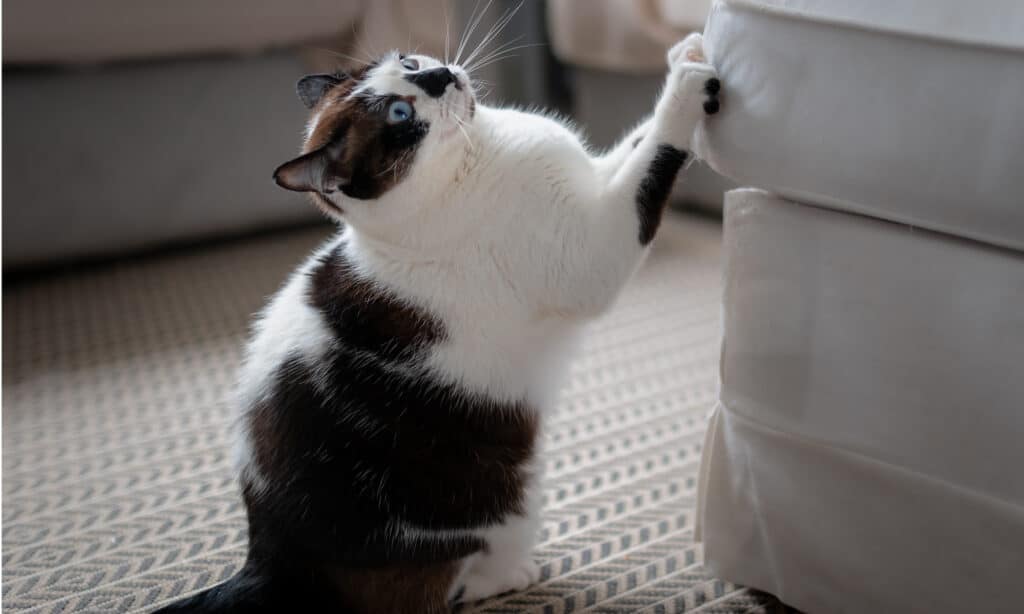
Almost all cats, both big and small, display scratching behaviors.
©iStock.com/Magui-rfajardo
Cats seem obsessed with their claws and frequently scratch on things, often to the detriment of your couch. Not only does scratching help a cat release tension and keep their claws healthy, but it also helps them mark their territory. Scent glands on their paws activate while scratching to tell other cats who’s in charge.
Something’s Different
Cats are professionals when it comes to hiding illness or injury. Cat parents know the worry that causes, but the best way to tell if something is wrong is to pay attention to your cat’s body language. If something suddenly changes, like their bathing routine, posture, or their neutral ear position, take it as a sign.
Final Thoughts
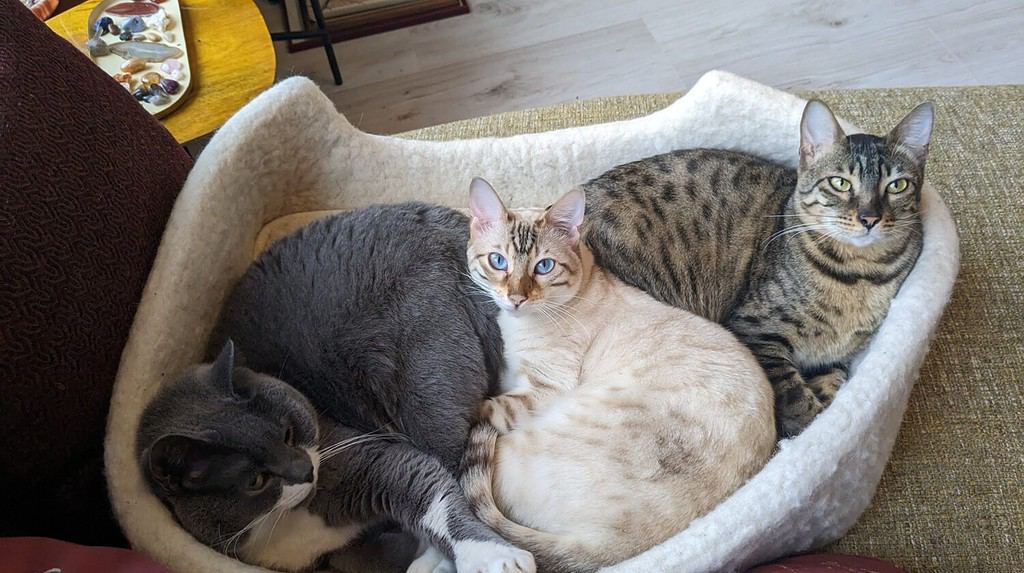
Cats love company and domestic cats specifically evolved to live in communities, either with other cats or with humans.
©Arwen Matthijssen/Shutterstock.com
For many people, cats are enigmas. Their body language is definitely different from other animals, true. However, with the right mindset, practice, and patience, these fuzzy felines are as easy to understand as our other animal companions. Hopefully, this guide helps dispel some of the mystery of cats — as much as they’d like to remain secretive and aloof, cats crave community and understanding, just like us.
The photo featured at the top of this post is © Rita_Kochmarjova/Shutterstock.com
Thank you for reading! Have some feedback for us? Contact the AZ Animals editorial team.






